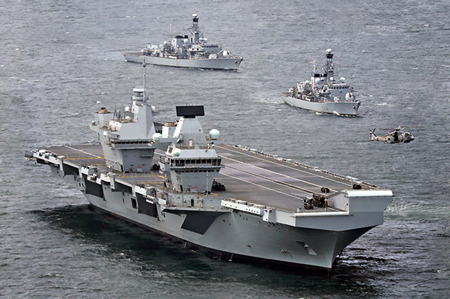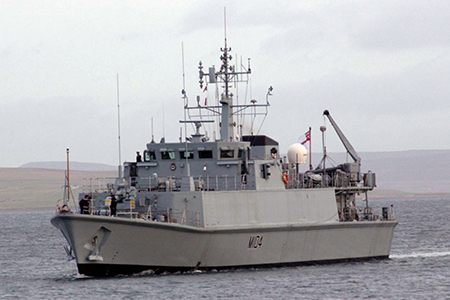Royal Navy adopts new mission control system that lets sailors work alongside “drone” mine hunters
In 1893 Hiram Maxim, inventor of the machine gun, predicted that his new weapon would make future war unthinkable.
History is littered with inaccurate predictions, especially where new technology is concerned. For Defence planners, technological advancement is one more factor to anticipate on top of which threats are emerging from shifting economic and political environments.
Artificial intelligence, autonomous systems, even human enhancement are here today and in less than a decade could be accessible to non-state adversaries, wiping out the battlefield advantages traditionally enjoyed by advanced nations.

From the invention of steam to the advent of air power, naval history shows that failure to keep up makes you a sitting duck. The UK Government recognised this challenge in its 2015 Strategic Defence and Security Review and in the maritime environment, always a testbed for innovation, change is already occurring.
Most visibly, new platforms are being designed and built: two new aircraft carriers; the Type 26 and Type 31 frigate, Astute Class submarines and the nuclear deterrent replacement platform. Less obvious are the new domains and technologies the Royal Navy is beginning to exploit, including autonomy, artificial intelligence and cyberwarfare.
However, the Navy also possesses a large number of vessels which must be maintained and modernised alongside new platforms as a deterrent and to preserve force resilience in the event of conflict. But how can these older platforms, designed in a different century, be usefully integrated with emerging technologies?
Mine Countermeasures and autonomy

The Royal Navy is a world leader in mine hunting operations. Her flotilla of 13 highly capable Hunt and Sandown class mine countermeasures vessels (MCMVs) and their well-trained crews are employed globally to make shipping lanes safer from mines, either the legacy of past conflict or the product of new ones. However, they could soon become obsolete as maritime autonomy technology is developed to make their intrinsically dangerous work safer.
Global defence and transport equipment developer Thales enjoys a long and successful partnership with the Royal Navy. They provide all the Navy’s sonar sensors, including the 2093 variable depth and 2193 hull mounted sonars used on her MCMVs.
Thales is also a key player in the ongoing Anglo-French Maritime Mine Countermeasures (MMCM) programme. Its aim is to replace the sailor in the minefield with a new generation of unmanned surface and underwater vessels carrying specialist mine hunting payloads.
At the heart of MMCM is M-Cube, Thales’s command and control (C2) system for coordinating deployed autonomous elements, collating and processing data for operator.
M-Cube and hybrid operations
Tried and tested, M-Cube is the most widely fitted MCM combat mission system (CMS) in the world, in service with the Lithuanian, Estonian and Thai navies with a derivative used by an undisclosed Asian customer.
M-Cube is based on Thales’s Tacticos-based CMS architecture, providing a bridging technology to enable hybrid mine countermeasures operations in which conventional MCMVs work in collaboration with USVs and UUVs.
The current CMS used in the Hunt and Sandown MCMVs is a product of its time, a large-scale, self-contained IT programme, never designed to integrate with other systems, and is expensive to update. This equipment has become obsolescent and no longer meets Royal Navy needs for the MCMVs’ remaining service life.
But as the Royal Navy moves forward with MHC, its future mine countermeasures and hydrography capabilities programme which will come out of MMCM, what was needed was something more akin to the smart phone concept; a phone leaves the factory with a standard operating system and suite of apps but the user can customise with extra functions and update when necessary, rather than replacing the phone.
ORCA
In 2018 the Royal Navy put to tender ORCA, the Oceanographic Reconnaissance Combat Architecture programme. Its goal was to address the obsolescence of its MCMV CMS to extend the service lives of the Hunt and Sandown vessels into the 2030s.
The Navy was looking for a new C2 system to bridge the gap between current mine hunting capabilities and the digital and autonomous technology being trialled in MMCM. The solution would require a flexibility and capacity to adapt swiftly and Thales beat international and domestic competition with M-Cube. Thales provides much of the Navy’s sensor requirements but ORCA represents a breakthrough in providing a C2 system for the first time.
“This contract is a ground breaker for the Royal Navy and for Thales UK,” said Thales’s bid capture leader Stuart Robinson. “It represents the Navy’s ability to transition to new technologies with new partners. It also showcases to the global market what we can do in the UK to develop off-board maritime systems that bridge current capabilities to future ones.
“M-Cube represents new capabilities and much more functionality in terms of the information it can display to operators and its contribution to decision making. It’s a significant uplift on what they currently have.”
Unlike its predecessor, M-Cube uses an open software architecture. A component-based approach allows rapid insertion of new capabilities by “third parties”, potentially via mission specific Apps to introduce new technologies, including maritime autonomy.
M-Cube can also integrate stand-alone operations room systems such as MTSS (Mine Warfare Tactical Support System), used for MCM planning and data analysis.
Although platform specific interfaces can be introduced and there is variation in screen configuration to accommodate different Operations Room layouts, the same core M-Cube solution will be used on both classes of vessel, facilitating commonality of training and upgrade delivery.
The contract for ORCA contract, which was signed in February 2019, includes training for Royal Navy personnel, a five-year in-service support plan and, for the first time for MCMVs, a land-based test site to develop future technologies and algorithms ashore. The Navy aims to have the first of Class ship to be fitted and M-Cube accepted into service early next year.
“The MOD as the customer wants a quick flash to bang on this,” said Stuart, “But M-Cube is essentially out-of-the-box hardware and software already in service elsewhere in the world. It’s relatively low risk and we wouldn’t have signed up to this if we didn’t think we could deliver within the timescale.”

An autonomous future
The strategic impact of winning the ORCA contract on both UK domestic and export markets is a significant success for Thales with interest growing in Europe and the Middle East.
ORCA also represents the Royal Navy’s traditional readiness to adopt new thinking to maintain its position as a leading global maritime force.
Simon Thomas, ORCA Chief Engineer at Thales, said: “The ORCA infrastructure should provide the backbone of the MHC CMS, allowing for system of system integration and the augmentation of traditional organic and future autonomous systems, enhancing the current capability whilst simultaneously exposing the user to the future of autonomous mine hunting in operational environments.
“The ORCA program is the first exposure the MOD will have to a different CMS provider and the ability for the RN to transition to a new system, along with a different approach to shared data, shared environments and 3rd party insertion (via app stores or other means) will inform the Type 31e program on what the art of the possible maybe in the future on a more complex warship.”
Most importantly, M-Cube empowers the Royal Navy to continue delivering on its front-line commitments with a modern, capable and open mine hunting system that will make the sailor’s job safer. The system’s wide use abroad also opens opportunities for more combined mine countermeasures operations with allies to beat an international problem.


